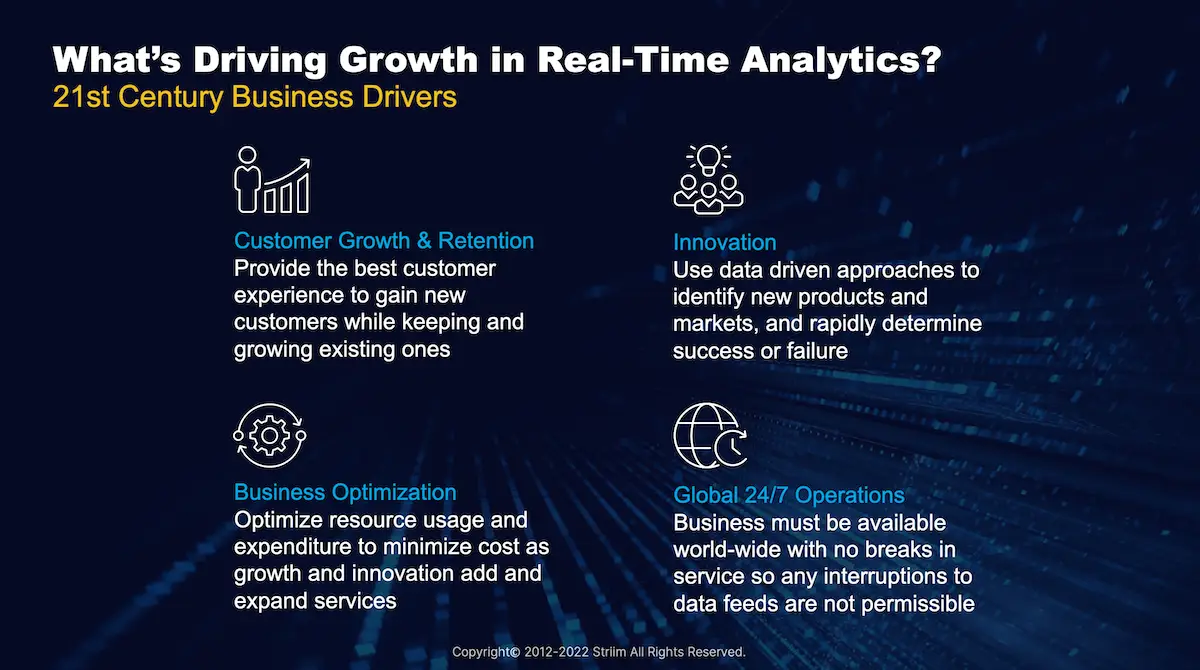According to IDC, by 2025 nearly 30% of data generated will be real time. Storing data and waiting minutes, days, or hours will no longer be sufficient (or practical) in a world that expects instantaneous responses. Companies need to ensure that they invest in technology solutions that enable real-time analytics so they can respond to key business events within seconds or milliseconds.
And responding in real time gives businesses an edge over companies that don’t. For example, instead of missing a key social media trend, an eCommerce store can jump on the trend and catch a wave of sales that it would have otherwise missed. Or a manufacturer can be alerted to a slowdown on a specific piece of equipment, and initiate repairs before it causes devastating cascading effects.
Real-Time Analytics Business Drivers
What are the business drivers behind the growth in real-time analytics? We’ve identified four key themes: customer experience, continuous innovation, business optimization, and 24/7 operations.
Customer Experience
Customer experience encompasses various facets of a customer’s interactions with an organization. First of all, customers expect accurate and up-to-date information at all times. According to Qualtrics research, customers are 80% more likely to be loyal to a company that communicates proactively about supply chain or labor shortage issues.
Furthermore, providing a good customer experience means that an organization understands what customers need (sometimes better than they do), and provides goods and services to meet those needs. Using real-time analytics, companies can provide personalized experiences that feel as though they’re tailored to each customer, in real time. For example, an online makeup retailer can recommend specific cosmetics brands based on a shopper’s purchase history, current trends, and inventory status. Instead of being a one-size-fits-all experience, online shopping becomes a 1:1 experience at scale.
Continuous Innovation
Continuous innovation refers to the data-driven introduction of new services and features based on an ongoing evaluation of available information. New services or features should be quantifiable to ensure that their success and bottom-line impact can be measured. Success should be assessed holistically based on overall impact, not solely on individual impact. For example, a company may add a new service or feature that doesn’t make money directly, but leads to a better customer experience that can in turn improve their bottom line. Organizations should be willing to fail fast and discontinue things that aren’t improving customer experience or providing a benefit to customers.
Customer problems are a key source of innovation. By observing their own customers, organizations have access to a wealth of data to inspire innovation. Furthermore, companies can glean insights by observing the problems experienced by customers of other organizations in their industry. Companies can also innovate based on problems they experience internally that could affect the bottom line.
Business Optimization
Adding, growing, and retaining customers requires well thought out investments in technology. Companies need to be able to scale and optimize their infrastructure and technology on an ongoing basis. Furthermore, in order to retain and grow their customer base, companies have to continuously improve the performance of their products or services, their response times, the freshness of their data, and more. To do this they need to quantify and measure insights relating to their online presence, productivity, and internal processes. This enables them to make much better decisions on how to optimize their business.
Many companies are also faced with the challenges associated with using legacy systems to manage their data. These systems may be prohibitively expensive to replace, or have very long replacement timescales, but the data that’s contained within those systems may be crucial for analytics. It’s essential that companies look at all the data they have – no matter where it is – and make use of that in order to optimize their business.
Reputation cost has to be factored into investments as well. Customer experience, security, and up-to-date data all factor into a company’s reputation. Organizations have to improve how they look to their customers and to the market in general, while managing with the challenges posed by their legacy systems.
Global 24/7 Operations
In the not-so-distant past, banks were open just for a few hours in the middle of the day. There was no online presence and organizations had the luxury of running batch ETL jobs overnight and they could even take down pieces of infrastructure or pause databases.
However, in today’s world global organizations need to operate 24/7. Taking down systems is no longer an option. Furthermore, services also need to be scalable and on-demand to match daily and seasonal seasonal trends. For example, in the retail industry, Black Friday has expanded from a single day to almost an entire month where companies expect much higher demand on their services. The same goes for financial services companies during tax season. And companies in the travel industry typically have to scale up around the holidays and summer.
Companies need to be able to scale up all of the services they provide; not only their core services, but also their analytics services to deal with the increased data volumes during peak times. Organizations can’t afford downtime. Customers want to get things done on their schedule. If a company is going to have any downtime, they need to at least notify customers ahead of time and give them a maintenance window. But in general, customers expect all businesses to operate 24/7 so they can access their information whenever they want.
Furthermore, if an organization has siloed or globally distributed information, it needs to be centrally available for analytics and holistic decision making.
Distilling the Key Business Requirements Driving Real-Time Analytics
In summary, there are a number of different requirements that are driving the growth in demand for real-time analytics:
- All Information: Analytics must be available across all sources of information, including new services and legacy systems
- Current Information: The data used for analytics must be as close to real-time as possible to provide customers and the business with timely insights
- Scalable on-demand: Systems need to grow as the business does, and be able to handle seasonal and daily changes in demand
- Globally Available: Analytics and access to data in general must be available wherever the business’s customers and employees reside
- No Downtime: Access to source systems should not be impacted by the need for analytics on the data in those systems
- Rapid Integration: New systems should be able to be added rapidly as sources for analytics as the business innovates
- Justifiable ROI: The investment in analytics and integration must be offset by improvements in the business
Next Steps: How to Choose the Correct Technology for Real-Time Analytics
Real-time analytics is a key component of digital transformation initiatives as companies strive to stay ahead of the competition. But there are many challenges in the journey to real-time, including how to leverage existing investments, and how to prevent or reduce downtime during the adoption of new systems.
Learn more about how to choose the correct technology for real-time analytics in our on-demand webinar “How to Build Streaming Data Pipelines for Real-Time Analytics”.
The webinar covers topics including:
- How to build real-time data streaming pipelines quickly, reliably, and at unlimited scale
- Why real-time data integration is an essential component of a streaming data pipeline
- Customer examples showing how streaming data pipelines enable companies to make informed decisions in real time
Watch the webinar here.























